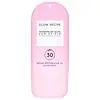What's inside
What's inside
 Key Ingredients
Key Ingredients

 Benefits
Benefits

 Concerns
Concerns

 Ingredients Side-by-side
Ingredients Side-by-side

Butyl Methoxydibenzoylmethane 3%
UV AbsorberHomosalate 7%
Skin ConditioningEthylhexyl Salicylate 5%
UV AbsorberWater
Skin ConditioningButyloctyl Salicylate
Skin ConditioningDiisopropyl Adipate
EmollientOleyl Erucate
EmollientNiacinamide
SmoothingGlycerin
HumectantCetearyl Alcohol
EmollientDiheptyl Succinate
EmollientAmmonium Polyacryloyldimethyl Taurate
Emulsion StabilisingPhenoxyethanol
PreservativeCoco-Glucoside
CleansingCapryloyl Glycerin/Sebacic Acid Copolymer
Skin ConditioningGlycine Soja Oil
EmollientXylitylglucoside
HumectantHydroxyacetophenone
AntioxidantTocopherol
AntioxidantAnhydroxylitol
HumectantParfum
MaskingCitrullus Lanatus Seed Oil
EmollientPongamia Pinnata Seed Extract
Skin ConditioningPolyglyceryl-3 Diisostearate
EmulsifyingXylitol
HumectantEthylhexylglycerin
Skin ConditioningHyaluronic Acid
HumectantOryza Sativa Extract
AbsorbentOryza Sativa Germ Extract
EmollientSodium Phytate
Glucose
HumectantHydrogenated Palm Glycerides Citrate
EmollientButyl Methoxydibenzoylmethane 3%, Homosalate 7%, Ethylhexyl Salicylate 5%, Water, Butyloctyl Salicylate, Diisopropyl Adipate, Oleyl Erucate, Niacinamide, Glycerin, Cetearyl Alcohol, Diheptyl Succinate, Ammonium Polyacryloyldimethyl Taurate, Phenoxyethanol, Coco-Glucoside, Capryloyl Glycerin/Sebacic Acid Copolymer, Glycine Soja Oil, Xylitylglucoside, Hydroxyacetophenone, Tocopherol, Anhydroxylitol, Parfum, Citrullus Lanatus Seed Oil, Pongamia Pinnata Seed Extract, Polyglyceryl-3 Diisostearate, Xylitol, Ethylhexylglycerin, Hyaluronic Acid, Oryza Sativa Extract, Oryza Sativa Germ Extract, Sodium Phytate, Glucose, Hydrogenated Palm Glycerides Citrate
Water
Skin ConditioningEthylhexyl Methoxycinnamate
UV AbsorberButyl Methoxydibenzoylmethane
UV AbsorberBenzophenone-3
UV AbsorberPhospholipids
Skin ConditioningButylene Glycol
HumectantGlycerin
HumectantZea Mays Starch
AbsorbentC12-15 Alkyl Benzoate
AntimicrobialTitanium Dioxide
Cosmetic ColorantSilica
AbrasiveDimethicone
EmollientAloe Barbadensis Leaf Juice
Skin ConditioningEthylhexyl Palmitate
EmollientIsopropyl Myristate
EmollientCitrullus Lanatus Fruit Extract
Skin ConditioningAcrylates/C10-30 Alkyl Acrylate Crosspolymer
Emulsion StabilisingSorbitan Stearate
EmulsifyingSucrose Cocoate
EmulsifyingSodium Lactate
BufferingGlyceryl Stearate
EmollientPEG-100 Stearate
Betaine
HumectantFructooligosaccharides
HumectantBeta Vulgaris Root Extract
Skin ConditioningTocopheryl Acetate
AntioxidantMenthyl Lactate
MaskingOxothiazolidine
Skin ProtectingPhenoxyethanol
PreservativeSodium Benzoate
MaskingSodium Hydroxide
BufferingSodium Gluconate
Skin ConditioningSodium Hyaluronate
HumectantWater, Ethylhexyl Methoxycinnamate, Butyl Methoxydibenzoylmethane, Benzophenone-3, Phospholipids, Butylene Glycol, Glycerin, Zea Mays Starch, C12-15 Alkyl Benzoate, Titanium Dioxide, Silica, Dimethicone, Aloe Barbadensis Leaf Juice, Ethylhexyl Palmitate, Isopropyl Myristate, Citrullus Lanatus Fruit Extract, Acrylates/C10-30 Alkyl Acrylate Crosspolymer, Sorbitan Stearate, Sucrose Cocoate, Sodium Lactate, Glyceryl Stearate, PEG-100 Stearate, Betaine, Fructooligosaccharides, Beta Vulgaris Root Extract, Tocopheryl Acetate, Menthyl Lactate, Oxothiazolidine, Phenoxyethanol, Sodium Benzoate, Sodium Hydroxide, Sodium Gluconate, Sodium Hyaluronate
Ingredients Explained
These ingredients are found in both products.
Ingredients higher up in an ingredient list are typically present in a larger amount.
Also known as Avobenzone, this ingredient is a chemical sunscreen filter that provides protection in the UV-A range.
Avobenzone is globally approved and is the most commonly used UV-A filter in the world.
Studies have found that avobenzone becomes ineffective when exposed to UV light (it is not photostable; meaning that it breaks down in sunlight). Because of this, formulations that include avobenzone will usually contain stabilizers such as octocrylene.
However, some modern formulations (looking at you, EU!) are able to stabilize avobenzone by coating the molecules.
Avobenzone does not protect against the UV-B range, so it's important to check that the sunscreen you're using contains other UV filters that do!
The highest concentration of avobenzone permitted is 3% in the US, and 5% in the EU.
Learn more about Butyl MethoxydibenzoylmethaneGlycerin is already naturally found in your skin. It helps moisturize and protect your skin.
A study from 2016 found glycerin to be more effective as a humectant than AHAs and hyaluronic acid.
As a humectant, it helps the skin stay hydrated by pulling moisture to your skin. The low molecular weight of glycerin allows it to pull moisture into the deeper layers of your skin.
Hydrated skin improves your skin barrier; Your skin barrier helps protect against irritants and bacteria.
Glycerin has also been found to have antimicrobial and antiviral properties. Due to these properties, glycerin is often used in wound and burn treatments.
In cosmetics, glycerin is usually derived from plants such as soybean or palm. However, it can also be sourced from animals, such as tallow or animal fat.
This ingredient is organic, colorless, odorless, and non-toxic.
Glycerin is the name for this ingredient in American English. British English uses Glycerol/Glycerine.
Learn more about GlycerinPhenoxyethanol is a preservative that has germicide, antimicrobial, and aromatic properties. Studies show that phenoxyethanol can prevent microbial growth. By itself, it has a scent that is similar to that of a rose.
It's often used in formulations along with Caprylyl Glycol to preserve the shelf life of products.
Water. It's the most common cosmetic ingredient of all. You'll usually see it at the top of ingredient lists, meaning that it makes up the largest part of the product.
So why is it so popular? Water most often acts as a solvent - this means that it helps dissolve other ingredients into the formulation.
You'll also recognize water as that liquid we all need to stay alive. If you see this, drink a glass of water. Stay hydrated!
Learn more about Water